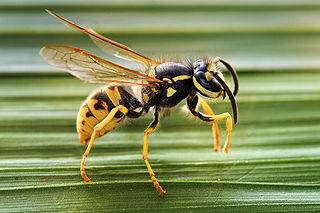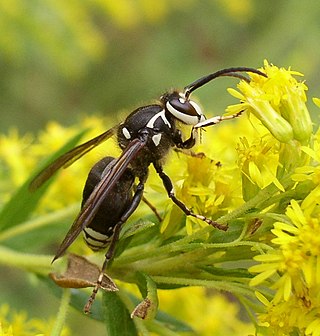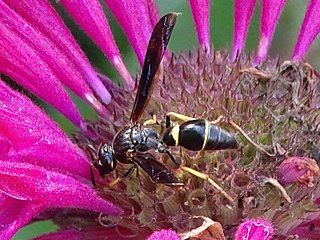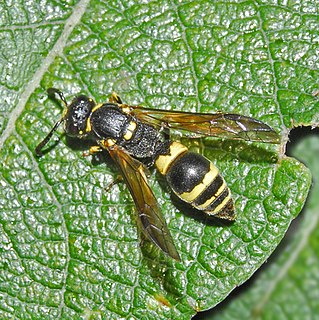
The Vespidae are a large, diverse, cosmopolitan family of wasps, including nearly all the known eusocial wasps and many solitary wasps. Each social wasp colony includes a queen and a number of female workers with varying degrees of sterility relative to the queen. In temperate social species, colonies usually last only one year, dying at the onset of winter. New queens and males (drones) are produced towards the end of the summer, and after mating, the queens hibernate over winter in cracks or other sheltered locations. The nests of most species are constructed out of mud, but polistines and vespines use plant fibers, chewed to form a sort of paper. Many species are pollen vectors contributing to the pollination of several plants, being potential or even effective pollinators, while others are notable predators of pest insect species, and a few species are invasive pests.

Polistes is a cosmopolitan genus of paper wasps and the only genus in the tribe Polistini. Vernacular names for the genus include umbrella wasps, coined by Walter Ebeling in 1975 to distinguish it from other types of paper wasp, in reference to the form of their nests, and umbrella paper wasps. Polistes is the single largest genus within the family Vespidae, with over 200 recognized species. Their innate preferences for nest-building sites leads them to commonly build nests on human habitation, where they can be very unwelcome; although generally not aggressive, they can be provoked into defending their nests. All species are predatory, and they may consume large numbers of caterpillars, in which respect they are generally considered beneficial.

Vespoidea is a superfamily of wasps in the order Hymenoptera. Vespoidea includes wasps with a large variety of lifestyles including eusocial, social, and solitary habits, predators, scavengers, parasitoids, and some herbivores.

Potter wasps, the Eumeninae, are a cosmopolitan wasp group presently considered a subfamily of Vespidae, but sometimes recognized in the past as a separate family, Eumenidae.

Cephalastor is a small neotropical genus of potter wasps currently containing 14 species.

Parazumia is a Neotropical and Nearctic genus of medium to large sized potter wasps. The Nearctic species of this genus have been treated for much of the 20th century as a separate genus named Paranortonia.

Pachodynerus is a fairly large neotropical and nearctic genus of potter wasps with higher diversity in central South America. At least one species has been introduced in other biogeographical regions, including several oceanic islands, while Pachodynerus erynnis occurs on Ascension Island as well as in North America. This genus is most closely related to the genus Euodynerus.

Anterhynchium is an Afrotropical, Indomalayan, Australian and Palearctic genus of potter wasps. As in many species of wasp, female wasps defend against predation using a modified ovipositor to sting predators. Like some other wasps in the Vespidae family, male wasps can produce a "pseudo-sting" with two sharp spines on either side of their genitals; however, unlike in the females, this "sting" is venomless.

Delta is an Old World genus of potter wasps with species predominantly distributed through tropical Africa and Asia. Some species are present in the Palearctic region, and a few have been introduced in the Nearctic and Neotropical regions. The members of this genus have a long metasomal petiole, like members of the genera Eumenes and Zeta.

Symmorphus is a primarily holarctic genus of potter wasps.within the family Vespidae.

Stenonartonia is a South American genus of potter wasps. The 15 known species of Stenonartonia are distributed across forested areas east of the Andes, with diversity concentrated on two areas: the Amazon basin and South-eastern Brazil. The distribution of Stenonartonia apicipennis seems to correspond with the distribution of the semideciduous dry forest system that crosses diagonally between the two above cited areas. Stenonartonia belongs to a group of genera with axillary fossa tending to be closed by the nearby structures. Those species in the group of Stenonartonia polybioides have further developed transparent pockets visible under the surface of the scutellum. Symbiotic mites get sheltered into those pockets and are sometimes visible under the cuticle.

Ropalidia is a large genus of eusocial paper wasps (Polistinae) in the tribe Ropalidiini distributed throughout the Afrotropical, Indomalayan and Australasian biogeographical regions. The genus Ropalidia is unusual because it contains both independent and swarm-founding species. Ropalidia romandi is one of the swarm founding species, meaning that new nests are founded by a large group of workers with a smaller number of inseminated females, while Ropalidia revolutionalis is independent-founding, meaning that each nest is founded by a single foundress.

Paraleptomenes is a primarily Indomalayan genus of potter wasps. There is a single species, Paraleptomenes miniatus, reported outside of the region, from the island of Mauritius in the Afrotropical region.

Pseudodynerus is a small Neotropical genus of potter wasps currently containing 16 species.
Leucodynerus is a Nearctic genus of small sized potter wasps distributed in south western United States and northern Mexico.
Okinawepipona is a small genus consisting of three species of East Asian potter wasps.

Pseudonortonia is a fairly large genus of potter wasps with a rich Afrotropical fauna, as well as with several species which occur throughout the Palearctic and Indomalayan regions.

Eumenes fraternus is a species of potter wasp in the subfamily Eumeninae of the family Vespidae. It is native to the eastern United States and Canada. The female builds a miniature pot out of mud in which it lays an egg and places a live caterpillar. Its developing larva feeds on this whereas the adult wasp feeds primarily on nectar.

Rhynchium brunneum is a species of potter wasp found in Asia. Across the wide distribution range, they show considerable variation in the patterning and several subspecies have been described, including:

Delta esuriens is a species of potter wasp found in tropical Asia, belonging to the Vespidae family. They can be separated from the similar looking Delta pyriforme by the presence of a yellow band on the metasomal petiole segment.

















